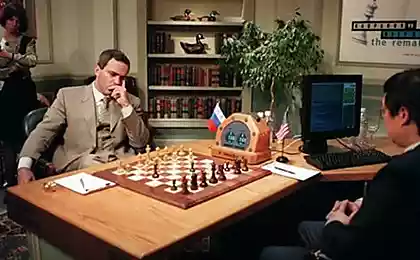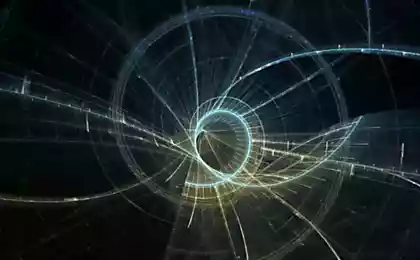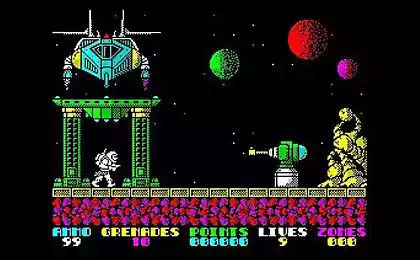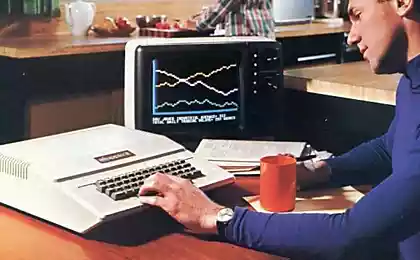1307
How the computer

Twenty-first century, few people imagine life without a computer.
Now, all the operations we carry out only on a computer. We become afraid to think that some text will have to write on paper, a pen, because we can do it on the computer, check all the errors, and print on the printer.
The computer does not have one "father" in its creation was attended by many people, is the fruit of collective intelligence, worthy child of worthy representatives of the human race!
Remind all the names is not possible, one can only note the key figures and key moments.
• The history of the computer is closely linked with attempts to simplify and automate all kinds of calculations. Already in antiquity appeared simplest counting device - abacus. Then came the abacus.
• In the XVII century. It was invented the slide rule - counting tool to simplify the calculations by which operations on numbers are replaced by operations on the logarithms of these numbers.
• In 1642, the French mathematician and physicist Blaise Pascal (Pascal; 1623-1662) constructed an eight summing machine.
• In 1820, Frenchman Charles de Colmar created a calculating machine capable of producing multiplication and division.
• In 1812, English mathematician and inventor Charles Babbage (Babbage; 1791-1871), decided to eliminate the error of logarithmic tables, came to the idea of mechanical calculation. In 1833, he drafted a machine for performing calculations. For the input and output data Babbage suggested using punch cards. Managing such a machine should be carried out by software.
• In 1833, the famous daughter of the famous poet Lord Byron - Englishwoman Ada Lovelace (Lovelace; 1815-1852) - are interested in Babbage's Analytical Engine. It was the first computer programmer, created the first program for this computer.
• In 1888, an American engineer Herman Hollerith (Hollerith; 1860-1929) built the first electromechanical computers. This machine, called the tabulator could read and sort the statistical records, encoded on punch cards. In 1890, Hollerith invention was first used in the 11 th US Census. The work was performed five hundred employees in seven years, Hollerith made with 43 helpers on 43 Tabs in one month.
In 1896, Herman Hollerith founded the company Tabulating Machine Company, which became the basis for future IBM (International Business Machines Corporation) - the company that has made a huge contribution to the world of computer technology.
Work on the theoretical basis for the computer went two parallel streams: the justification of the hardware and software of the study. But since the computer works with the information needed to begin to understand what it is - information?
One of the founders of the mathematical theory of information - Amer. engineer and mathematician Claude Elwood Shannon (Claude Shannon; 1916-2001) - in 1948 published a paper "Mathematical Theory of Communication", in which he presented his unified theory of information transmission and processing. According to Shannon information includes all types of messages, including those that are transmitted along the nerve fibers in living organisms. Shannon proposed to measure information in a mathematical sense, reducing it to a choice between two, or binary digits - "yes" or "no" (1 or 0, true or false, there is a signal or no signal, closed circuit or open). < br /> • In 1944, at one of IBM's collaboration with scientists at Harvard University commissioned by the US Navy was established machine "Mark-1". It was a monster weighing about 35 tons. "Mark 1" was based on the use of electromechanical relays and operated decimal numbers encoded on a punched tape. The machine could manipulate the numbers up to 23 digits. To multiply two 23-bit numbers it needed four seconds.

Electromechanical relays work fast enough. Thus began the development of alternative - the computer based on vacuum tubes. In 1946 he built the first electronic computer ENIAC. It weighed 30 tons, it is required to accommodate 170 square meters. Square meters. Instead of thousands of electromechanical components ENIAC contained 18,000 vacuum tubes. Considered a car in the binary system and produced five thousand three hundred additions or multiplications per second.

The machine vacuum tube is much faster, but the electron tubes often fail. And in 1947, American physicists John Bardeen (Bardeen; 1908-1991), Walter Brattain (Brattain; 1902-1987) and William Bradford Shockley (Chockley; 1910-1989) proposed the use of invented "stable switching semiconductor elements" - Transistors (in 1956 for this invention, they received the Nobel Prize).
In parallel with Shannon American mathematician and philosopher Norbert Wiener (Norbert Wiener; 1894-1964) is working on a theory of cybernetics and artificial intelligence.
Cybernetics - the science of the general patterns of management and information transfer in machines, living organisms and society. Cybernetics develops the general principles of management systems and systems for the automation of mental labor. The main technical means for solving the problems of cybernetics - the computer. Therefore, the emergence of cybernetics as an independent science, connected with the creation of 40-ies. XX century. Computers, and the development of cybernetics in the theoretical and practical aspects - with the progress of computer technology.
• In the 50-ies. XX century. It began active implementation of transistors in the electronics industry. A transistor 40 is able to replace vacuum tubes. As a result, machine speed increased 10 times while substantially reducing weight and size. As computers began to use storage devices of the magnetic cores, capable of storing large amounts of information.
• In 1959, invented integrated circuits (chips) in which all the electronic components together with the conductors placed inside a silicon wafer. The use of chips in computers can reduce the path of current flow during switching, and computing speed increases tenfold. And significantly reduces the size of cars.
• The process of miniaturization has allowed in 1965 the American company Digital Equipment PDP-release 8 minicomputer price of 20 thousand. Dollars, which made the computer accessible to small and medium business companies.
Further, after the process of the invention, integrated circuits, computers have been reduced dimensions

In 1970, an employee of Intel, Ted Hoff created the first microprocessor, by placing several integrated circuits on a single silicon chip. This 8-bit microprocessor called the 4004, was a "computer in a single chip." These chips are also suggested Motorola and Zilog. With microprocessor appear Microcomputers - computers capable of accommodating on the desk user.
In the sale of the processor entered only in the mid-seventies.
In 1973 he was released Intel-8008 microprocessor, which was an 8-bit.
• In the 70-ies. attempts to create a PC - a computer designed for one - personal! - User (company Xerox, Apple). Widespread personal computers received with the creation in August 1981 by IBM model microcomputer IBM PC. The triumphal march of the PC! ..

























